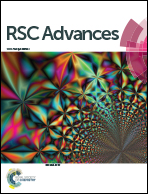Amino acid-based ionic liquid surface modification of magnetic nanoparticles for the magnetic solid-phase extraction of heme proteins†
Abstract
In this study, magnetic nanoparticles with an amino acid-based ionic liquid directly modified onto their surface were fabricated as a new magnetic adsorbent (Fe3O4@DIH–EMIMLpro) for the magnetic solid phase extraction of protein. The synthesized Fe3O4@DIH–EMIMLpro nanoparticles were characterized using Fourier transform infrared spectrometry, transmission electron microscopy, vibrating sample magnetometry, X-ray diffraction and thermogravimetric analysis. Hemoglobin was chosen as a model protein to investigate the extraction performance of the prepared materials. After extraction, the concentration of protein in the supernatant was determined by UV-vis spectrophotometry. The adsorbed hemoglobin could be eluted from the Fe3O4@DIH–EMIMLpro nanoparticles by sodium dodecyl sulfate solution. The Fe3O4@DIH–EMIMLpro nanoparticles could be used for rapid, efficient, and selective adsorption of hemoglobin with a binding capacity as high as 1.58 mg mg−1. Moreover, the extraction process of protein from human whole blood by Fe3O4@DIH–EMIMLpro has been performed to evaluate the practical application of the proposed method.



 Please wait while we load your content...
Please wait while we load your content...